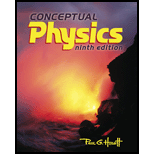
Why are more and more fire engines being painted yellow-green instead of red?
Explain, the reason for most of the fire engines are being painted yellow-green instead of red.
Explanation of Solution
Introduction:
Generally, the fire engine painted in red. But considering safety, human visibility, and auditory perception most of the fire engines painted yellow-green.
The human eye has a hundred million rod cells and only six millions of cones. Rods help with very low levels of light and are used for night vision only. Only a few bits of light activate the rods and they cannot help with a color vision that is why the human eye can see only gray color in the night. On the other hand, the cone requires a lot more light and they are used to see the color. Cones in our eyes do not work well in the dark or night. But some colors are easiest to see at night by the human eye. The human eye is more sensitive to greenish-yellow colors under dark conditions. So, the green-yellow makes the easiest to see in low lighting also.
Conclusion:
The fluorescent colors, including yellow-green, is easiest to spot in daylight.
Chapter 28 Solutions
CONCEPTUAL PHYSICS-W/PRACTICING PHYSICS
Additional Science Textbook Solutions
Microbiology with Diseases by Body System (5th Edition)
Introductory Chemistry (6th Edition)
Concepts of Genetics (12th Edition)
Applications and Investigations in Earth Science (9th Edition)
Anatomy & Physiology (6th Edition)
Microbiology: An Introduction
- ! Required information The radius of the Moon is 1.737 Mm and the distance between Earth and the Moon is 384.5 Mm. The intensity of the moonlight incident on her eye is 0.0220 W/m². What is the intensity incident on her retina if the diameter of her pupil is 6.54 mm and the diameter of her eye is 1.94 cm? W/m²arrow_forwardRequired information An object is placed 20.0 cm from a converging lens with focal length 15.0 cm (see the figure, not drawn to scale). A concave mirror with focal length 10.0 cm is located 76.5 cm to the right of the lens. Light goes through the lens, reflects from the mirror, and passes through the lens again, forming a final image. Converging lens Object Concave mirror 15.0 cm -20.0 cm- 10.0 cm d cm d = 76.5. What is the location of the final image? cm to the left of the lensarrow_forward! Required information A man requires reading glasses with +2.15-D refractive power to read a book held 40.0 cm away with a relaxed eye. Assume the glasses are 1.90 cm from his eyes. His uncorrected near point is 1.00 m. If one of the lenses is the one for distance vision, what should the refractive power of the other lens (for close-up vision) in his bifocals be to give him clear vision from 25.0 cm to infinity? 2.98 Darrow_forward
- ! Required information Assume that the magnifier is held close to the eye. Use the standard near point of 25.0 cm to find the angular magnification. An insect that is 4.10 mm long is placed 10.3 cm from a simple magnifier with a focal length of 13.0 cm. What is the angular magnification?arrow_forward2arrow_forward3arrow_forward
- Imagine you are out for a stroll on a sunny day when you encounter a lake. Unpolarized light from the sun is reflected off the lake into your eyes. However, you notice when you put on your vertically polarized sunglasses, the light reflected off the lake no longer reaches your eyes. What is the angle between the unpolarized light and the surface of the water, in degrees, measured from the horizontal? You may assume the index of refraction of air is nair=1 and the index of refraction of water is nwater=1.33 . Round your answer to three significant figures. Just enter the number, nothing else.arrow_forwardDeduce what overvoltage is like in reversible electrodes.arrow_forwardpls help on thesearrow_forward
- pls help on thesearrow_forward20. Two small conducting spheres are placed on top of insulating pads. The 3.7 × 10-10 C sphere is fixed whie the 3.0 × 107 C sphere, initially at rest, is free to move. The mass of each sphere is 0.09 kg. If the spheres are initially 0.10 m apart, how fast will the sphere be moving when they are 1.5 m apart?arrow_forwardpls help on allarrow_forward
 College PhysicsPhysicsISBN:9781305952300Author:Raymond A. Serway, Chris VuillePublisher:Cengage Learning
College PhysicsPhysicsISBN:9781305952300Author:Raymond A. Serway, Chris VuillePublisher:Cengage Learning University Physics (14th Edition)PhysicsISBN:9780133969290Author:Hugh D. Young, Roger A. FreedmanPublisher:PEARSON
University Physics (14th Edition)PhysicsISBN:9780133969290Author:Hugh D. Young, Roger A. FreedmanPublisher:PEARSON Introduction To Quantum MechanicsPhysicsISBN:9781107189638Author:Griffiths, David J., Schroeter, Darrell F.Publisher:Cambridge University Press
Introduction To Quantum MechanicsPhysicsISBN:9781107189638Author:Griffiths, David J., Schroeter, Darrell F.Publisher:Cambridge University Press Physics for Scientists and EngineersPhysicsISBN:9781337553278Author:Raymond A. Serway, John W. JewettPublisher:Cengage Learning
Physics for Scientists and EngineersPhysicsISBN:9781337553278Author:Raymond A. Serway, John W. JewettPublisher:Cengage Learning Lecture- Tutorials for Introductory AstronomyPhysicsISBN:9780321820464Author:Edward E. Prather, Tim P. Slater, Jeff P. Adams, Gina BrissendenPublisher:Addison-Wesley
Lecture- Tutorials for Introductory AstronomyPhysicsISBN:9780321820464Author:Edward E. Prather, Tim P. Slater, Jeff P. Adams, Gina BrissendenPublisher:Addison-Wesley College Physics: A Strategic Approach (4th Editio...PhysicsISBN:9780134609034Author:Randall D. Knight (Professor Emeritus), Brian Jones, Stuart FieldPublisher:PEARSON
College Physics: A Strategic Approach (4th Editio...PhysicsISBN:9780134609034Author:Randall D. Knight (Professor Emeritus), Brian Jones, Stuart FieldPublisher:PEARSON





